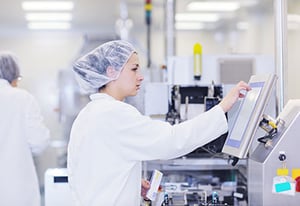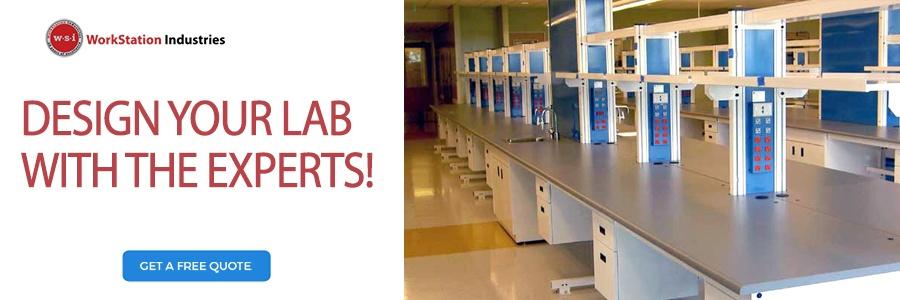Designing labs can be complicated. To stay competitive, companies have to be flexible to market changes. New products and services mean changes in operations.
For companies that have labs, this can be costly. Many companies make poor choices to save money and don’t plan ahead. In the long run, this leads to additional, often unforeseen costs and safety issues.
If you’re purchasing new laboratory furniture, here are the top 6 lab design mistakes companies make. Below, we’ll dive into how you can avoid them:
- Cheap imported furniture may seem like a good bargain.
- Your design has no flexibility.
- You purchase the most economical countertops.
- Ergonomics is overlooked in your design.
- You don’t plan ahead for technology changes.
- Sustainability isn’t a priority.
Cheap Import Furniture A Good Bargain? Not So Fast
Many companies think that they can save money by buying cheap imported products. There are many businesses overseas that will tout inexpensive lab benches, lab tables, laminar flow workstations and seating. But there are risks to doing this, and cheap imported furniture may end up costing you more in the long run.
Often, these products have limited or no warranties, have quality and safety issues, and can be difficult to get replacement parts for when something goes wrong. It is not uncommon for additional money to be spent after these purchases are made because of repairs that are needed. You may even find that the purchase you made ended up being an expensive long-term investment.
Furniture quality isn’t the only concern when buying cheap imported furniture. Opting for cheap furniture may also entail challenges related to shipping and customs. While the initial cost might seem appealing, more expensive shipping costs can offset the perceived savings. Customs clearance processes can lead to longer shipping times, causing delays in the setup of your laboratory.
Resolving issues can also be complicated due to language barriers and differing regulatory frameworks. This lack of recourse can result in prolonged downtime for your laboratory operations.
Choosing American-made furniture offers more advantages, from higher-quality craftsmanship to shorter shipping times and often easier communication with the manufacturer. Make sure you work with a manufacturer whose products have been UL Listed or meet ANSI BIFMA standards.
Design With Flexibility In Mind
What companies are doing in their labs today, may not be what they are doing tomorrow. This is especially true because  of the continuing advancement and addition of new instruments, equipment, and robotics in lab environments.
of the continuing advancement and addition of new instruments, equipment, and robotics in lab environments.
Many companies don’t build flexibility and adaptability to change into their lab designs. They purchase traditional fixed cabinetry and then later pay the price as things change. Then, they are either stuck with a design that is no longer functional for their work or have to spend more money on a redesign.
Forward-thinking companies design with modular workstations and mobile casegoods. Multiple configurations ensure that the lab space remains adaptable to evolving research needs. This proactive approach not only saves costs associated with redesign but also enhances overall efficiency and productivity as companies seamlessly transition between different workflows and technologies in their laboratories.
It’s important to keep in mind that there should be a level of daily flexibility as well. If your lab operates in multiple shifts, an adjustable height workbench can accommodate varying user preferences and ergonomic needs, promoting comfort and productivity throughout different work periods. This feature ensures that each shift can optimize the workstation according to their specific requirements, contributing to a more efficient and adaptable laboratory environment.
Choose Your Countertop Based On What Happens In Your Lab
Companies that look to save money on their countertops could be headed for problems and end up spending more money than they planned.
There are a lot of factors that go into selecting the right countertop material for your lab. Most of these factors revolve around what happens in your laboratory on a day-to-day basis.
If your lab deals with harsh conditions and you require countertops that offer resistance to bacteria, chemicals, corrosive substances, fungus, moisture, water, scratches and heat exposure, the most economical countertops just won’t do.
Instead, an investment in laboratory work surfaces like phenolic resin, epoxy resin or chemical laminate will better ensure that your money is better spent. Our article, Top 5 Materials To Consider For Your Countertops, explains some of the advantages and disadvantages of these worksurfaces.
You may also need to consider ESD laminate surfaces, which should be incorporated into your lab design if your work involves sensitive electronic components or activities where electrostatic discharge could pose a risk. ESD laminate surfaces provide a controlled environment, preventing the buildup and discharge of static electricity that could potentially damage electronic equipment and ensuring the integrity of your sensitive experiments and instruments.
Don’t Overlook The Importance Of Ergonomics
Technology has changed how people work in labs, so employees spend a lot more time sitting. Recent research has shown that too much sitting can lead to major health risks.
Unfortunately, many companies still aren’t taking ergonomics seriously. Incorporating ergonomics means looking at the overall picture of how your employees do their work, the quality of their seating, the location of the tools and the movements that go into their workday.
Here are a few ways you can incorporate ergonomics as you design your lab:
- Adjustable Seating: Provide lab chairs with adjustable height and lumbar support to accommodate different body types and ensure proper posture during extended periods of sitting.
- Height-Adjustable Lab Tables: Install workbenches and tables with adjustable heights, allowing employees to switch between sitting and standing positions to reduce the risks associated with prolonged sitting.
- Task-Specific Tool Placement: Organize tools and equipment based on task frequency and importance, minimizing repetitive movements and reducing strain on employees.
- Screen Placement: Ensure that computer monitors and screens are positioned at eye level to reduce neck strain and eye fatigue, promoting a more comfortable and productive workspace.
A quality industrial furniture manufacturer can work with you to design the right workspace for your employees, ensuring their long-term comfort, health and safety are prioritized.
Plan Ahead For Evolving Technology That Is Inevitable
I can’t tell you how many companies don’t tell us important pieces of information about their technology plans. They are  so busy doing other things that they often forget to tell us about big pieces of equipment that need to be accounted for, how many people will be working in their lab or data and electrical needs.
so busy doing other things that they often forget to tell us about big pieces of equipment that need to be accounted for, how many people will be working in their lab or data and electrical needs.
Planning for this up front is crucial, because oversight can be very costly. If you have to bring in contractors in a hurry or after the fact to make changes, you will be paying extra money for their time.
Having a design now, with plans for growth that includes the use of the lab furniture you are planning to put in, will save you a big headaches and money later.
Have a Plan For Sustainability
When companies forget to account for large numbers of containment and exhaust devices, heat-generating equipment, 24-hour access for scientists and the need for fail-safe redundant backup systems and uninterrupted power supply (UPS) or emergency power, this can be a problem waiting to happen.
Smart companies focus on energy-efficient technologies, including air quality monitoring systems, water conservation and recycling, heating technology and low energy exhaust systems.
They also consider the materials they use in the lab, opting for sustainable and environmentally friendly choices when possible to minimize the ecological footprint of their laboratory operations. This approach aligns with modern sustainability standards and promotes a greener, more responsible lab infrastructure.
For example, stainless steel is recyclable, and the material itself is durable, long-lasting and resistant to corrosion. That’s why many labs with specific hygiene requirements opt for stainless steel cabinets and countertops.
There is a lot to consider when planning your laboratory design and lab layout, from your budget to lab requirements. Reputable lab casework manufacturers have the experience and knowledge to help you with this planning process that in the end will provide you with a lab that can serve you well today and long into the future.


